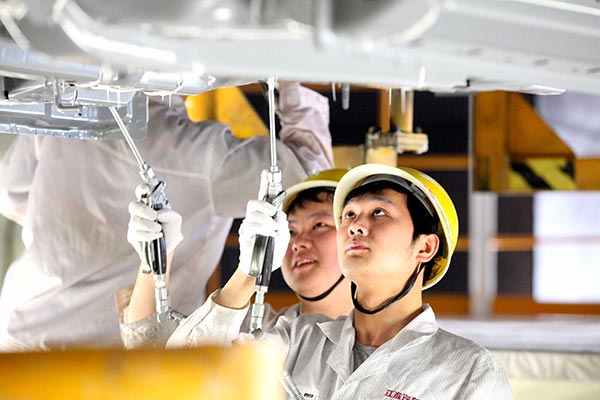Why China can achieve its 6.5% growth rate target
By John Ross (chinadaily.com.cn) Updated: 2016-03-10 13:09
 |
|
Workers at the production line of Anhui Jianghuai Automobile Co Ltd in Hefei, capital of Anhui province. [Photo provided to chinadaily.com.cn] |
China announced GDP growth target of at least 6.5% during the 13th Five-Year Plan in 2016-2020 and 6.5%-7.0% for 2016 at the National People's Congress. Some Western economists claim such targets cannot be achieved. In fact, analysis of supply-side factors, which will primarily be relied on to achieve this goal, shows clearly why China can achieve its 6.5% minimum growth target.
Current international economic trends, particularly trade, are undoubtedly unfavourable owing to slow growth in the advanced economies. Slow trade growth negatively affects China's supply side by limiting its ability to benefit from international division of labour. In the next period, China will consequently have to rely primarily on domestic supply-side factors to achieve its growth targets. Data on global growth in turn shows clearly which are the most powerful economic supply-side forces and why these can successfully allow China to achieve its targets.
To understand the fundamental reason China can achieve its economic goals the starting point is that an economy's growth rate is strictly determined by the percentage of fixed investment in GDP divided by what is known as the Incremental Capital Output Ratio (ICOR) – the latter being a measure of the efficiency of investment, and equal to the percentage of GDP that has to be invested for the economy to grow by 1%. For China the latest internationally comparable World Bank data for these, for 2014, showed that China’s percentage of fixed investment in GDP was 44.3% and its incremental capital output ratio was 6.1. China's GDP growth rate was therefore 7.3%.
Since 2014 the percentage of fixed investment in China’s GDP has fallen, probably to around 42-43% of GDP, which will be assumed to show why China can achieve its 6.5% growth target. Supply-side factors may then be divided into the rate of fixed investment and those which determine the efficiency of that investment (ICOR).
The most powerful supply-side factor for all countries studied is what is known technically as 'intermediate products' – one industry's inputs into another which reflect increasing division of labour throughout the economy's supply chain. In the US, the world's most advanced economy, 52% of economic growth is due to growth in such intermediate products.
Growth of intermediate products is also crucial for understanding the role of innovation. Innovation is not just a few 'big bang' inventions. As an economy is an interconnected network it can only be as strong as its major weakest links. For example, merely installing the most modern machinery in a factory will not yield optimal results if there is not an adequate supply of component parts, if there is not sufficiently skilled labour, if the logistics system does not efficiently take products to and from the factory etc. Given the economy's interconnectedness every part must function efficiently for successful operation. China has therefore stressed applying innovation across the entire economy. Such a supply-side division of labour requires a multitude of factors ranging from infrastructure to product standardisation – all of which China has to develop further for its supply-side to function efficiently.
The second most powerful supply side factor is fixed investment – which is above all required to incorporate technological upgrading. Leaving aside intermediate products, internationally fixed investment accounts for 61% of economic growth.
The third most powerful supply-side factor is growth in quantity and quality of labour – accounting for 29% of GDP growth globally. Given China’s working age population is not expanding, improvements in education and skill are a decisive factor in this area.
Other inputs (scale of production, individual entrepreneurship etc) account for an average 10 percent of growth globally. These are technically termed Total Factor Productivity (TFP) and contribute to China's supply side development.
Taking these factors together shows why China's 6.5% growth rate is entirely realistic and why the claims of Western critics are erroneous. Given the fundamental ratios already outlined then for China’s economic growth rate to fall below 6.5%, from its 6.9% level in 2015, one or both of two things would necessarily have to occur. Either China’s ICOR, its efficiency of investment, would have to deteriorate substantially, or the percentage of fixed investment in China’s GDP would have to decline in a major way.
Without one or both of these occurring it is simply numerically impossible for China's growth rate to fall significantly. Those critics claiming that China's economy will not meet its 6.5% growth target, and who either do not explain why China's level of investment or its efficiency of investment are going to drastically decline, are engaging in economic 'hot air' – unwarranted claims without any serious factual basis.
Given China's current investment level and the efficiency of that investment there is no reason why it will not achieve its 6.5% growth rate.
The author is a Senior Fellow at Chongyang Institute for Financial Studies, Renmin University of China.
The opinions expressed here are those of the writer and don't represent views of China Daily website.











